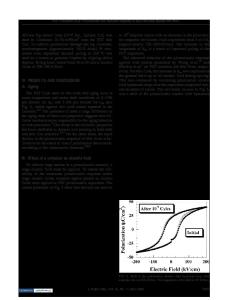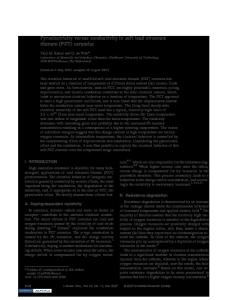Mechanical Quality Factor of Lead Zirconate Titanate/Epoxy Composites
- PDF / 552,859 Bytes
- 6 Pages / 612 x 792 pts (letter) Page_size
- 98 Downloads / 339 Views
Mechanical Quality Factor of Lead Zirconate Titanate/Epoxy Composites K.C. Cheng, H.L.W. Chan, S.W. Or and C.L. Choy Department of Applied Physics and Material Research Centre, The Hong Kong Polytechnic University, Hung Hom, Kowloon, Hong Kong, PR CHINA. ABSTRACT The mechanical quality factor Qm of 1-3 piezoelectric lead zirconate titanate/epoxy composites with ceramic volume fractions φ ranging from 0.18 to 0.82 has been measured. This range of φ is wider than those previously investigated by other workers. The width-to-thickness ratio of the ceramic phase is sufficiently small that there are no significant mode couplings. The observed Qm agrees well with the prediction of the parallel model. It is found that Qm increases from 34 to 100 as φ changes from 0 to 0.82 and then increases sharply to reach a high value of 600 at φ = 1. Therefore Qm can be tailored to give a wide range of values by varying φ. INTRODUCTION 1-3 composites figure 1 consist of ceramic rods embedded in a polymer matrix. The reason why it is called a 1-3 composite is that the ceramic rods are connected in one dimension while the polymer is 3 dimensionally connected. They have attracted considerable interest [1-5] because they can be used to fabricate ultrasonic transducers that have acoustic impedance close to that of human tissue and water. The recent trend of employing second harmonic imaging in medical ultrasound and nondestructive evaluation has called for the use of broadband transducers. 1-3 composites would be ideal for making these transducers since their bandwidth can be tailored by varying the ceramic volume fraction φ. As there is mechanical wave attenuation in the composite arising from both the ceramic and the polymer phase, it is important to estimate the mechanical loss and mechanical quality factor of the composite as a function of φ.
Figure 1. Schematic diagram of a 1-3 composite
CC6.38.1 Downloaded from https://www.cambridge.org/core. The Librarian-Seeley Historical Library, on 12 Jan 2020 at 07:55:54, subject to the Cambridge Core terms of use, available at https://www.cambridge.org/core/terms. https://doi.org/10.1557/PROC-628-CC6.38
In the present work, 1-3 composites of lead zirconate titanate (PZT) rods embedded in an epoxy matrix have been studied. Composite samples of thickness 1.5 mm were fabricated by the diced-and-filled technique using PZT7A ceramic from Morgan Matroc and Araldite D with hardener HY951 from Ciba Geigy. A wafer dicing saw with a blade thickness of 75 µm was used to dice the ceramic but due to blade vibration, the resulting grooves in the ceramic were 80 µm wide as measured by a travelling microscope. By using ceramic widths of 75 µm to 1 mm, composite disks with φ varying from 0.18 to 0.82 were prepared. EXPERIMENT Determination of Qm of epoxy The mechanical quality factor Qm and mechanical loss factor tan δm of a solid are related to the longitudinal wave attenuation coefficient α at frequency f by: [6,7] Qm =
π f 1 = tan δ m α v L
(1)
where νL is the longitudinal wave velocity. The Qm factor of
Data Loading...











